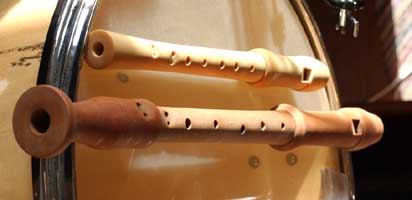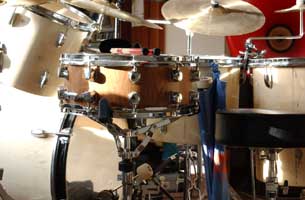
The Effect of Lacquer
If you play a musical instrument which is made of wood (i.e. violin, guitar, electric guitar, drums, piano, etc.) you know that there are differences in the quality between instruments, not only in the ease of playing or looks but also concerning the sound.
According to the Mother of Tone chapter, every musical instrument that is made of wood must sound good, because of the good sonic character of the wood.
If you are a musician, you know, that this is not at all the case. Some instruments sound exceptionally beautiful while others sound plain bad. Maybe you have blaimed it on different wood qualities.
Of course there are different wood qualities. Some say, that you can never duplicate the sound of a '57 LesPaul electric guitar, because this quality of wood is no more available.
Recently it has been found out that the sound quality is largely dependent on the lacquer that was originally used.
Some of you may have heard that also the sound character of a Stradivari is said to be connected to the lacquer of the instrument.
Today, the Gibson Custom Shop builds some expensive and good-sounding guitars, using the old nitro-cellulose lacquer (which is a problem because of environmental and health issues).
All other electric guitars from Gibson and other manufacturers, are lacquered with modern synthetic lacquers, such as acrylic or polyurethane lacquers. Instruments that are lacquered with these artificial substances, look very good, have a durable finish, but sound just like crap. The tone does not come through, it is damped in the plastic. The tone adapts the soft artificial sound character of the plastic lacquer.
What makes things even worse, those instruments do not age. They stay that crappy way, since the wood can neither breathe or dry, nor vibrate in its own fashion. Even the old nitro-cellulose lacquer is far from optimum, but it as it is made of cellulose (the basic building block of a plants structure) is more related to wood than a synthetic lacquer. It also builds cracks with the time and the wood can breathe and age.
Have you ever wondered why some musicians play guitars where large parts of the lacquer have chipped off ? It is not that they cannot afford one of the dirt-cheap new instruments that look so perfect.
So my question is: Can the cheapest Gibson, Fender, Squier or any Korean made guitar have a high-quality sound, if it is not packed into a thick plastic lacquer package but is treated with a natural lacquer ?
Well, this is easy to find out: I invested $180,- in a Squier Affinity Stratocaster. The looks and buildt-quality of this guitar are really satisfying, but does it sound any good ? No, it sounds just like shit. Not at all like a Strat (or any electric guitar) should sound. The tone on any pickup is muddy, with short sustain, and no definition. The character of the tone is a plastic character that gave me a good headache after a short time of playing.
So I disassembled the guitar and grinded the complete lacquer off the neck and the body. After having completed this stinky and dusty affair, I knocked on the guitar body, and it sounded like wood again, the plastic character was gone. Bare wood, ready to finish...
Your Private Lacquer Kitchen
As Wood Sounds Good, the ideal lacquer is made of wood: natural resins and turpentine-oil.
A variety of natural resins is available, such as amber (fossil), burgundy (spruce), colophony (pine), copal (fossil), dammar (diptocarpaceae) and so on. Turpentine-oil is made of pine balsam through destillation. The remainder is colophony-resin. The balsam of a tree is needed for protection against rain and insects. It is needed to keep the tree alive.
Not all natural resins dissolve in turpentine. Some need alcohol or acetone, others (such as fossil amber) can be cooked in linseed-oil. You may be able to get this stuff in paint supply shops.
The easiest available and cheapest resin is colophony, so the basic lacquer I tried on my spruce hifi-speaker enclosures, horn speakers, guitar amps, musical speakers, etc. is just colophony dissolved in turpentine. This is an excellent lacquer (soundwise) but remains sticky for a longer time, which is a feature we do not want on a guitar neck or body.
The resin of spruce is called burgundy resin and it is not so sticky as colophony. so I dissolved this in turpentine-oil and gave the grinded guitar a new finish. You can apply that stuff with a brush or wipe on with an old T-shirt. Burgundy lacquer also needs a small amount of oil, in order to avoid water stains. Use linseed-oil or just the corn-oil from your kitchen.
You may also want to order Dieter's excellent C37 violin lacquer which is much more complex, yet more expensive.
I also replaced the soft plastic pickguard with a wood pickguard and removed the plastic caps from the pickups. Btw. those old fender pickguards were made of celluloid, and thus sound much better than modern plastic pickguards. However, a wooden pickguard sounds best.
I lacquered the new pickguard and the pickups.
Okay, soundcheck: The guitar now looks different, and sounds great . It has to sound great, since all the features that made it sound bad before have been removed. Every tone now has its own quality and is privately identified by the ear. Each and every note played is its own reward. A completely new experience, no more haste in playing, you can pluck one note, enjoy it, and you can stay with it in confidence.
The feedback character is unmatched, let it sing...
It is just a joy playing, and I immediately realized that if I had a guitar like this before, together with a good sounding spruce-amp it would have been much easier and more fun to learn on the instrument.
Also, an instrument that is treated only with natural resins, can breathe, vibrate and age in a natural way. The more you play it the better it gets, whereas instruments that are dipped into plastic lacquers still sound like shit when you are long gone. Do you have so much time ?
With this package, I did a couple of guitars with burgundy, amber, copal, dammar, all with excellent results.
Some guitars:
I also tried this with recorder flutes. In this modern times, even school recorders are packed into plasitic lacquers. How can you learn music, when every single note is ugliness ?
Recently I lacquered a complete drum-set. Most drumsets are wrapped into a plastic foil or treated with synthetic lacquers.
Before I drift into further detail about sound improvements, lets sum this up:
Normally when we read about musical instruments or hifi-gear, we get a list of extraordinary features, and it all sounds very complicated. We are used to evaluate in feature lists.
But now that we have identified the simple law "Wood Sounds Good" we should also look from exactly the other direction:
We need to know, what is absent in the design, not what is present.
The Absence of Distortion Mechanims
Any musical device sounds good, when the distortion mechanims that would make it sound bad, are not present.
For example: What must be absent for any electric guitar to sound good:
1) plastic lacquer
2) plastic pickguard
3) pickups that are filled with plastics
If you want to evaluate any musical device, don't look for special features, look for the absence of distortion mechanisms.
For any musical instrument: The absense of plastic lacquer is much more important than what kind of wood is used.
For any speaker, musical or hifi: The enclosure should be made of real wood (not particle or mdf), plastic lacquer or even plastic enclosures must be absent.
The - Mother of Tone - Material for cones is Paper, not polypropylene, kevlar, aluminium, titanium or other materials. The same holds true for the voice-coil former.
So, if we can identify distortion mechanisms and are able to avoid their application, what is left is indeed a good sound.
Altmann Micro Machines … Dipl.-Ing. Charles Altmann… Erlenstrasse 15… 42697 Solingen… Germany
phone +49-212-233-7039… email
- Other Altmann Sites: www.jitter.de www.altmann.haan.de www.amm.haan.de
- AMM reserves the right to make changes without further notice to any products herein to improve reliability, function or design.






